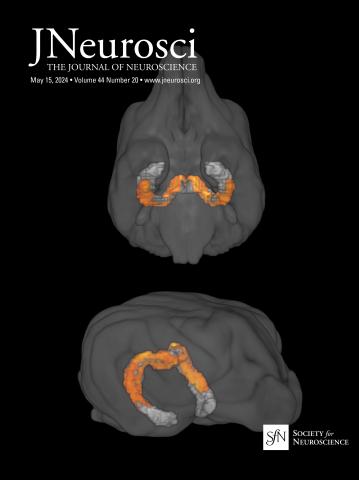Task-Switch Related Reductions in Neural Distinctiveness in Children and Adults: Commonalities and Differences.
IF 4.4
2区 医学
Q1 NEUROSCIENCES
引用次数: 0
Abstract
Goal-directed behavior requires the ability to flexibly switch between task sets with changing environmental demands. Switching between tasks generally comes at the cost of slower and less accurate responses. Compared to adults, children often show greater switch costs, presumably reflecting the protracted development of the ability to flexibly update task-set representations. To test whether the distinctiveness of neural task-set representations is more strongly affected by a task switch in children compared to adults, we examined multi-voxel patterns of fMRI activation in 88 children (8-11 years, 49 girls, 39 boys) and 52 adults (20-30 years, 27 women, 25 men) during a task-switching paradigm. Using multivariate pattern analysis (MVPA), we investigated whether task-set representations were less distinct on switch than on repeat trials across frontoparietal, cingulo-opercular, and temporo-occipital regions. Children and adults showed lower accuracy and longer response times on switch than on repeat trials. Switch costs were similar across groups. Decoding accuracy was lower on switch than repeat trials, suggesting that switching reduces the distinctiveness of task-set representations. Reliable age differences in switch-related reductions of decoding accuracy were absent. More nuanced analyses using probability measures indicated that the distinctiveness of task sets was more affected by switch demand in children than in adults in a subset of frontal, cingulate and temporal regions. These results point to a remarkable degree of maturity of neural representations of task-relevant information in late childhood along with more subtle region-specific age differences in the effects of task switching on rule representation.Significance statement The ability to flexibly switch between tasks enables goal-directed behavior, but is particularly challenging for children, potentially due to protracted development in the ability to represent multiple and overlapping task rules that link stimuli to appropriate responses. We tested this hypothesis using functional MRI to measure brain activity during task switching in 8-11-year-olds and adults. Activation patterns in frontal, parietal, and temporal regions indicated with above-chance accuracy which task a person was performing when the task remained the same, but not when it had switched. Children showed larger differences in a subset of frontal and temporal regions when tasks switched, suggesting more subtle age differences in the contributions of developing rule representations to flexible behavior.儿童和成人神经独特性的任务转换相关降低:共性与差异。
目标导向的行为要求有能力根据环境需求的变化灵活地在任务组之间切换。在不同任务之间切换的代价通常是反应更慢、更不准确。与成人相比,儿童往往表现出更大的转换成本,可能反映了灵活更新任务集表征的能力的长期发展。为了验证任务转换对儿童神经任务集表征的影响是否比成人更强烈,我们在任务转换范式中检测了88名儿童(8-11岁,49名女孩,39名男孩)和52名成年人(20-30岁,27名女性,25名男性)的功能磁共振成像激活的多体素模式。使用多变量模式分析(MVPA),我们调查了任务集表征在切换时是否比在重复试验时在额顶叶、扣带回眼和颞枕区差异更小。与重复试验相比,儿童和成人在开关试验中表现出较低的准确性和较长的反应时间。不同群体的转换成本相似。切换时的解码准确率低于重复实验,这表明切换降低了任务集表征的独特性。在开关相关的解码精度降低中,没有可靠的年龄差异。使用概率测量的更细致的分析表明,在额叶、扣带和颞叶区域的一个子集中,儿童的任务集的独特性比成人更受开关需求的影响。这些结果表明,在儿童晚期,任务相关信息的神经表征具有显著的成熟程度,同时任务转换对规则表征的影响存在更微妙的区域特定年龄差异。在任务之间灵活切换的能力可以实现目标导向的行为,但对儿童来说尤其具有挑战性,这可能是由于儿童在表现多个和重叠的任务规则(将刺激与适当的反应联系起来)的能力方面的长期发展。我们使用功能性核磁共振成像来测试8-11岁儿童和成人在任务转换过程中的大脑活动。额叶、顶叶和颞叶区域的激活模式在任务保持不变时准确地显示了一个人正在执行的任务,而在任务转换时则没有。当任务转换时,儿童在额叶和颞叶区域的一个子集中表现出更大的差异,这表明在发展规则表征对灵活行为的贡献方面存在更微妙的年龄差异。
本文章由计算机程序翻译,如有差异,请以英文原文为准。
求助全文
约1分钟内获得全文
求助全文
来源期刊

Journal of Neuroscience
医学-神经科学
CiteScore
9.30
自引率
3.80%
发文量
1164
审稿时长
12 months
期刊介绍:
JNeurosci (ISSN 0270-6474) is an official journal of the Society for Neuroscience. It is published weekly by the Society, fifty weeks a year, one volume a year. JNeurosci publishes papers on a broad range of topics of general interest to those working on the nervous system. Authors now have an Open Choice option for their published articles
 求助内容:
求助内容: 应助结果提醒方式:
应助结果提醒方式:


